Ten research innovations and inventions from the University of Bradford, 1966-present
Since its inception in 1966, the University has been producing inventions and innovations with a global impact. Below are a selection of our most noteworthy success stories...
1960s
Shaping the future of global journal publishing
Global company Emerald Publishing was formed by a group of Bradford academics unhappy with the state of academic publishing.
Dr Keith Howard led an academic team at the School of Management to set up ‘Management Consultants Bradford’ and they bought their first journal, ‘Management Decision’, in 1968 for just £1. From this initial journal, the company has grown to produce more than 350 publications today.
The business became Emerald Publishing in 2002 to reflect the success of its Emerald Fulltext database, an innovative online resource for publications. Despite having offices across the world, they still have a strong community foothold in Bradford and the region. Their Head Office is in Bingley and they sponsor a Master’s scholarship programme at the University of Bradford.
Read more about Emerald Publishing's history on their website.

1970s
A world first in peacebuilding
In 1973 Adam Curle was appointed as the world’s first Chair and Professor of Peace Studies, marking the beginning of what is now a globally recognised centre for the analysis of peace, conflict and development issues.
The Quaker Peace Studies Trust funded Adam Curle’s appointment and have continued to support the department as it has established itself. In the last fifty years, the expertise of the teachers, researchers and graduates in the Department of Peace Studies and International Development are constantly in demand by global governance institutions such as the UN, World Bank, EU, Africa Union and major development co-operation partners and donor agencies working in the Global South countries, and are often the first port of call for international media seeking comment, analysis and insight into world events.
Closer to home, the research team at Bradford played a vital role in reconciliation following the Bradford riots of 2001 through the Programme for a Peaceful City (PPC) project when ongoing tensions between deprived, multi-ethnic communities in the city grew. The engagement approach adopted by the project contributed to non- confrontational responses to English Defence League (EDL) activities in Bradford.
Read more about the 50th anniversary of the Peace Studies department.
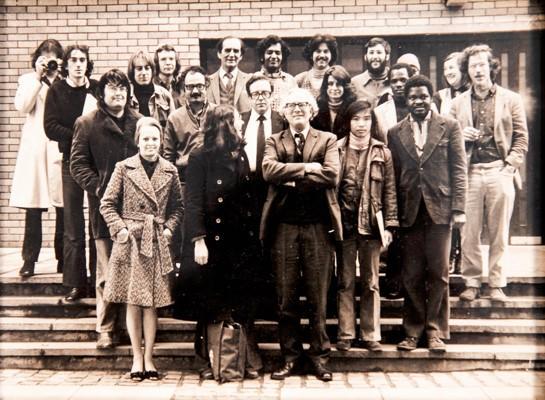
Professor Adam Curle (centre) and the first Peace Studies staff photograph
1970s
Instruments to uncover the buried past
From the 1960s to 70s, Bradford researchers, led by Dr Arnold Aspinall, pioneered a measurement technique which became the standard method for earth resistance surveys worldwide: the ‘Twin Probe’, which came to public attention in the 1990s on popular archaeology TV programme Time Team.
Along with industrial and academic partners, the University of Bradford influenced the development of commercial survey instruments in the field of geophysical prospection, and increased the public understanding of non-invasive techniques of recording the buried past.
Bradford later researched into the ‘Square Array’ to measure earth resistance, which offered improved data interpretation and survey speed. The system, commercialised by Bradford company Geoscan Research, has been exported all over the world and is now used widely for archaeological heritage management and for development planning purposes.
Geophysical Prospection became more widely known by the use of Bradford’s techniques in Channel 4’s Time Team in the 90s programme watched by two to three million regular viewers interested in archaeological investigation. As a result of the visible demonstration of the techniques pioneered by the Bradford group, community groups have done surveys of their own with Heritage Lottery funded projects continuing to provide startling discoveries in locations such as Durrington Walls and under the North Sea.
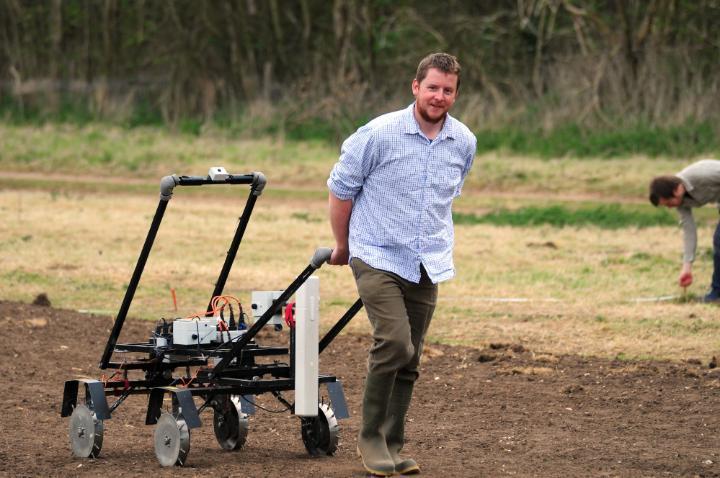
A PhD researcher using Geoscan Research’s prototype Square Array for an earth resistance survey
1980s
An elevating invention for hand injuries
The tragedy of the Bradford City fire of 1985 led to an invention that has become an essential part of the treatment of hand injuries across the world.
The tragic fire at Valley Parade, Bradford City FC's home ground on 11 May 1985 was devastating to the city and local community, but the legacy of the event led to new safety measures for football stands and saw the creation of the internationally renowned Bradford Burns Unit, a partnership between the Department of Plastic and Reconstructive Surgery at the Bradford Royal Infirmary and the Centre for Skin Sciences at the University of Bradford.
The Burns Unit was founded by the late Professor David Sharpe OBE, the consultant plastic surgeon at Bradford at the time, who was faced with treating at least 258 people with burns, many to their hands, which in part led to the creation of the Bradford Sling®.
The Bradford Sling® is designed to suspend the arm or strap it to a patient’s body, applying even pressure whilst safely immobilising the arm to prevent damage to injured areas. A proportion of all revenues for the sling go to Bradford Hospitals.
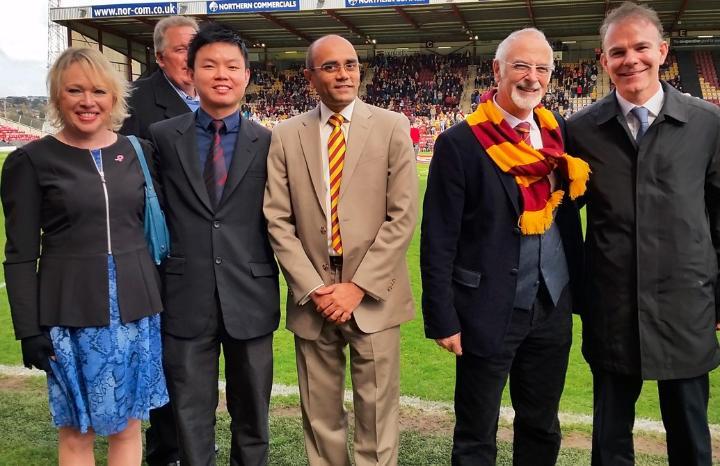
Professor David Sharpe OBE (second from right), inventor of the Bradford Sling with representatives from the Bradford Burns Unit at Valley Parade.
1990s
Putting people at the heart of dementia care
The Bradford Dementia Care Mapping (DCM) is a pioneering tool that enables practitioners to evaluate care from the perspective of the person with dementia.
Since the DCM’s inception in 1995, staff at the Centre for Applied Dementia Studies have built on the legacy of its inventor, the late Professor Tom Kitwood, to progress the concept of ‘person-centred care’, regularly revising and updating the tool to ensure it meets the needs of care practitioners and people with dementia.
In 2015, the University of Bradford was awarded a coveted Queen’s Anniversary Prize for Higher and Further Education for its world-leading dementia work, including the Dementia Care Mapping tool and other work focused on two key themes: helping people to live well with dementia and improving the quality of care for people with dementia.
For more than 25 years, DCM has been used to improve quality of life for people living with dementia in a range of care settings, including care homes and hospitals, with more than 10,000 care practitioners receiving training.
-480x320.jpg)
2000s
A $200 million idea that transformed pharmaceutical manufacturing
A University of Bradford company, formed from ground-breaking crystallisation technology, sold for $200 million six years after it was created.
Bradford Particle Design (BPD) was founded in 1995 as a spin-out venture by a team including Professor Peter York from the University of Bradford Pharmacy department, and quickly grew to a successful pharmaceutical organisation with more than 40 staff and an annual turnover of £1.5 million. Among its innovations, BPD developed the Solution Enhanced Dispersion by Supercritical Fluids (SEDS) system to control powder formation from a diverse range of chemicals, including inorganic and organic substances, plastics, peptides and proteins.
SEDS creates continuous and uniform crystallisation using carbon dioxide, which is relatively stable, non-toxic, inexpensive and non-flammable. The technique simplifies manufacturing, quality assurance and regulatory approval and is now used widely in pharmaceuticals and to decaffeinate coffee amongst other applications.
The company and its ground-breaking technology was acquired by American pharmaceutical company Inhale in 2001 for $200 million (£136 million).
CrystecPharma, a company spun out from the University in 2007, continues to use a version of this technology and works with the pharmaceutical and health care industries to solve drug particle formation, formulation and process challenges.
See the Telegraph and Argus report about the sale from December 2000.

2010s
Using plastics to solve health challenges
Tiny plastic products designed by University of Bradford researchers prove their worth in the health market by improving patients’ experiences and being easy to make and use.
Working with former dental products company, DRFP, the Bradford Centre for Polymer Micro and Nano Technology (Polymer MNT) team developed a better and easier way to fill a root canal’s cavity in 2010, especially awkwardly shaped ones. A bespoke material and a hydrophilic (water soluble) coating were created for the application to ensure a complete 3D seal, which was a major improvement on traditional treatment approaches. In addition, the Bradford team was able to develop the polymer material so that it consistently combines the necessary ceramic powder ingredients to make it visible on x-rays and exhibits properties compatible with mass-manufacturing techniques - qualities that that DRFP had been unable to source anywhere else.
Clinical trials have shown that the device has reduced the five-year failure rate of root canal treatments from 30 per cent to one per cent, and patients have reported excellent healing and much lower levels of post-operative pain.
The Polymer MNT has also produced the CORONET device which enables precision cutting for donor cornea tissue transplantation, PEEK beads to help stabilise the vertebrae after spinal surgery, and coated solid and hollow microneedles which have a variety of medical applications.
More examples of commercial applications on the Polymer MNT website.
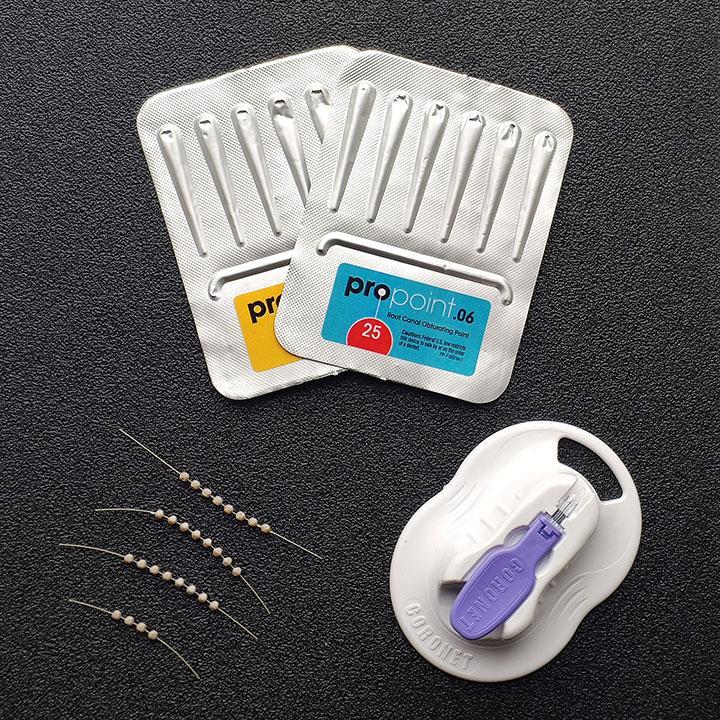
The Smart Point cavity treatments manufactured by DRFP, the CORONET device and PEEK beads used in spinal surgery.
2010s
Public generosity supports cancer breakthroughs
The development of a new natural drug targeting cancer tumours without damaging the body, has since led to the purchase of cutting-edge research equipment and other unique cancer treatments.
Research at the Institute of Cancer Therapeutics (ICT) led to the development of the Crocus Smart-Bomb, which targets tumours whilst minimising damage to the rest of the body, reducing side effects from traditional chemotherapies and improving patient prognoses and survival. The ‘smart bomb’ treatment comes from colchicine, a natural compound found in the autumn crocus plant, and further research showed that it works even better in combination with a standard chemotherapy agent, doxorubicin.
This compound, known as ICT2588, along with prodrugs of another toxic anticancer agent, paclitaxel, were later patented by the University, leading to University spinout company Incanthera. In July 2017, Ellipses Pharma acquired the rights to ICT2588 for £4.9 million.
Work on the crocus smart bomb ICT2588 inspired the birth of the Bradford Crocus Appeal, a charitable initiative between the University of Bradford, the Telegraph & Argus, Yorkshire Cancer Research, and the Sovereign Health Care Community Fund, launched in May 2013. The two-year appeal raised more than £1 million, enabling the purchase of a new state-of-the-art Orbitrap mass spectrometer – an essential piece of equipment for identifying new potential drug targets and in developing new cancer treatments.
The ICT continues to innovate targeted ‘prodrug’ approaches to rare cancers such as neuroblastoma and osteosarcoma and to unique features within solid tumours.
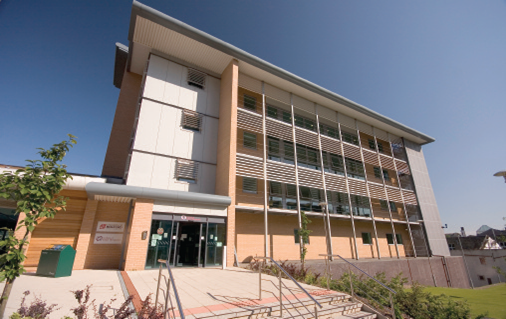
The Institute of Cancer Therapeutics, University of Bradford
2010s
AI set to revolutionise the organ donation process
The University of Bradford has been instrumental in pioneering a new AI method to assess the quality of organs for donation. This new method is set to revolutionise the transplant system and in turn save lives and tens of millions of pounds in healthcare costs.
The technology, first conceived in 2016, known as OrQA - Organ Quality Assessment, is based on a deep machine learning algorithm, which will be trained using thousands of images of human organs to assess organ quality more effectively than the human eye.
This project has received over £1 million in funding from the National Institute for Health and Care Research (NIHR) and could result in up to 200 more patients receiving kidney transplants and 100 more liver transplants a year in the UK.
The technology uses AI learning originally developed by Prof Hassan Ugail for identifying individuals, known as deep face recognition, which itself has been instrumental in various high-profile criminal cases across the world.

2020s
Innovative crystal engineering technology a huge win for the environment
Award-winning ‘crystal engineering’ technology invented at the University of Bradford - marketed under the registered trademarks EfferShield® and EfferShine® - has had a massive impact on the manufacturing process of effervescent products, including a range of benefits for the environment.
The citric acid and sodium bicarbonate in traditional effervescent products causes them to fizz in humid conditions, requiring humidity-free manufacturing and packaging. EfferShield® and EfferShine® eliminate this issue, which opens up a range of benefits, including huge CO2 savings during manufacturing, vast reduction in transport costs and a reduction in the salt content of things like vitamin tablets and other supplements.
There are also significant environmental benefits in that tablets can be sold in environmentally friendly compostable packaging. This has a particular impact in the eco-cleaning market as every tablet used means one less plastic bottle in the environment, potentially translating to millions fewer bottles every year.
The products are made under trademark by Skipton-based Health Innovations and Liversedge-based Octopoda Innovations, bringing a boost to Yorkshire businesses. They are available in stores across the UK and will be available in Europe soon.
Read the University's coverage of the product launch for more details.
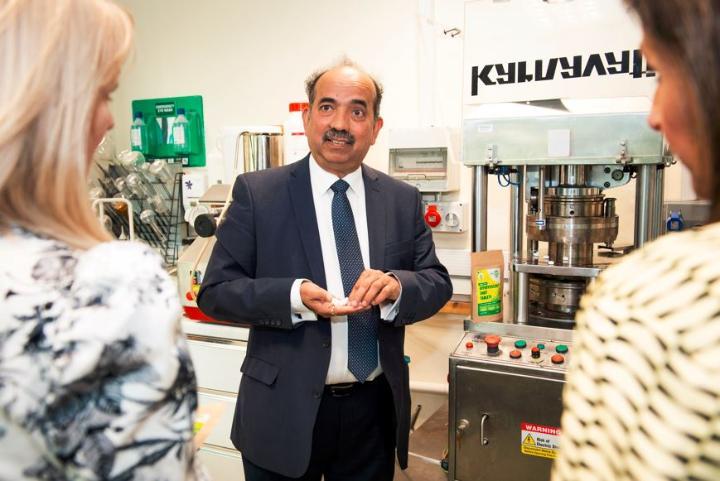
Project lead Prof Anant Paradkar demonstrating the EfferShield® and EfferShine® products.
Request a booklet
The above information is also available in a full-colour 12-page A5 booklet. If you'd like a free copy please email [email protected].
If you're an organisation interested in working with us, you can find out more about our offer on our business services pages.
